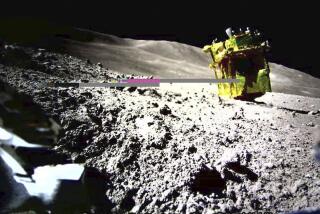Radiation Zaps Galileo Probe’s Cameras
- Share via
NASA’s Galileo spacecraft was unable to record its closest encounter with Jupiter’s moon Io after a blast of radiation shut down its cameras and other instruments, the space agency said Friday.
NASA was able to get the instruments working four minutes later, allowing Galileo to complete more than half its planned observations of Io and another moon, Europa.
The Io fly-by took place Thursday night. Galileo passed within 186 miles of Io’s surface--a risky maneuver because the moon is deep within the Jovian system’s radiation belts.
Four hours before the point of closest approach, radiation caused a failure in the spacecraft’s computer, Jet Propulsion Laboratory spokeswoman Jane Platt said. Galileo turned off its cameras, stopped receiving data through its science instruments and waited for instructions from controllers on Earth.
It will take weeks for all of the information collected by the spacecraft to be transmitted to Earth.
Several of Galileo’s systems had been damaged during an October fly-by of Io. But the spacecraft returned data showing that the moon is even more active than previously known, with more than 100 erupting volcanoes and vast lava flows.
More to Read
Sign up for Essential California
The most important California stories and recommendations in your inbox every morning.
You may occasionally receive promotional content from the Los Angeles Times.













